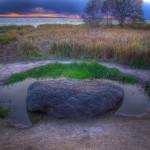National Park Lake Pleshcheyevo (Pereslavl-Zalessky)
Lake Pleshcheyevo is a unique natural object of scientific, historical and cultural significance. It is one of the largest fresh water lakes in Central Russia of glacial-karst origin, which is over thirty thousand years old.
The Lake has an elliptical shape, its area is 5 089 hectares, length is 9.55 kilometres, the widest span — 6.7 kilometres, the maximum depth — 24.3 metres. The lake is open, around 19 rivers and creeks flow into it. The largest tributary of the lake is the Trubezh River — 36 kilometres, flowing from the Bereny marsh. Only one river — the Veksa, 8 kilometres long, flows out of the lake. It takes its waters to the Somino Lake, where the Volzhskaya Nerl starts from — the Volga River’s tributary.
The water in the lake is pure and cold. Sixteen kinds of fish of six families live here. The most well-known among the fish fauna of the Pleshcheyevo Lake is the Pereslavl ryapushka — a relict fish of the cisco family — the famous “Tsar’s herring” which was caught in the old days for the tsar’s and patriarch’s tables. This could be the reason why the Pereslavl ryapushka is present on the coat of arms of Pereslavl-Zalessky. As an endemic, the Pereslavl ryapushka has been added to the Red List of Threatened Species of the Russian Federation.
On the banks of the Pleshcheyevo Lake there is an archaeological site “Kleshchensky Complex.” In the ancient times, the Merya and the Slavs tribes had their settlements here. Pereslavl’s predecessor, Kleshchin city, was its centre, which has preserved its earth mounds of the 12th century.
At the foot of the hills, on the bank of the lake, there is the famous Blue Stone — a legendary huge rock of glacier origin, greyish-blue in colour; the object of a cult worship of our ancestors. It lies on the north-eastern shore of the lake.
The stone weighs 12 tons. In the old days, our pagan ancestors worshipped the Nature: trees, birds, stones. The Blue Stone was one of the idols. The stone was adorned, danced around, sacrifices were made to it. The adoption of Christianity did not change the people’s reverence for the stone. Secular authorities and the Orthodox church were very concerned over such foul conduct of the people. They fought with the stone — dug it into the ground, drowned it in the water, but to no avail. The Blue stone stubbornly returned to the lake’s shore.
The archaeological complex also includes the Alexander’s Mount, or the Yarilo’s Bare patch, where in the ancient days the tribes of Merya and Slavs also lived.
Some materials have been used for the following web-resource: http://plesheevo-lake.ru


